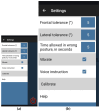Quantitative Evaluation of Postural SmartVest's Multisensory Feedback for Affordable Smartphone-Based Post-Stroke Motor Rehabilitation
- PMID: 40724102
- PMCID: PMC12294414
- DOI: 10.3390/ijerph22071034
Quantitative Evaluation of Postural SmartVest's Multisensory Feedback for Affordable Smartphone-Based Post-Stroke Motor Rehabilitation
Abstract
Accessible tools for post-stroke motor rehabilitation are critically needed to promote recovery beyond clinical settings. This pilot study evaluated the impact of a posture correction intervention using the Postural SmartVest, a wearable device that delivers multisensory feedback via a smartphone app. Forty individuals with post-stroke hemiparesis participated in a single supervised session, during which each patient completed the same four-phase functional protocol: multidirectional walking, free walking toward a refrigerator, an upper-limb reaching and object-handling task, and walking back to the starting point. Under the supervision of their therapists, each patient performed the full protocol twice-first without feedback and then with feedback-which allowed within-subject comparisons across multiple metrics, including upright posture duration, number and frequency of posture-related events, and temporal distribution. Additional analyses explored associations with demographic and clinical variables and identified predictors through regression models. Wilcoxon signed-rank and Mann-Whitney U tests showed significant improvements with feedback, including an increase in upright posture time (p<0.001), an increase in the frequency of upright posture events (p<0.001), and a decrease in the total task time (p=0.038). No significant subgroup differences were found for age, sex, lateralization, or stroke chronicity. Regression models did not identify significant predictors of improvement.
Keywords: digital intervention; mHealth; multisensory feedback; postural balance; smartphone application; stabilization; stroke rehabilitation; wearable technology.
Conflict of interest statement
The authors declare no conflicts of interest. The funders had no role in the design of the study; in the collection, analyses, or interpretation of data; in the writing of the manuscript; or in the decision to publish the results.
Figures











Similar articles
-
Wearable Smartphone-Based Multisensory Feedback System for Torso Posture Correction: Iterative Design and Within-Subjects Study.JMIR Aging. 2025 Jan 22;8:e55455. doi: 10.2196/55455. JMIR Aging. 2025. PMID: 39841997 Free PMC article.
-
'Smart reminder': A feasibility pilot study on the effects of a wearable device treatment on the hemiplegic upper limb in persons with stroke.J Telemed Telecare. 2025 Jul;31(6):796-806. doi: 10.1177/1357633X231222297. Epub 2024 Jan 9. J Telemed Telecare. 2025. PMID: 38196179 Clinical Trial.
-
Activity monitors for increasing physical activity in adult stroke survivors.Cochrane Database Syst Rev. 2018 Jul 27;7(7):CD012543. doi: 10.1002/14651858.CD012543.pub2. Cochrane Database Syst Rev. 2018. PMID: 30051462 Free PMC article.
-
Physical rehabilitation approaches for the recovery of function and mobility following stroke.Cochrane Database Syst Rev. 2014 Apr 22;2014(4):CD001920. doi: 10.1002/14651858.CD001920.pub3. Cochrane Database Syst Rev. 2014. Update in: Cochrane Database Syst Rev. 2025 Feb 11;2:CD001920. doi: 10.1002/14651858.CD001920.pub4. PMID: 24756870 Free PMC article. Updated.
-
Real-Time Postural Feedback to Optimize Ergonomics and Musculoskeletal Health in Ophthalmology Residents: A Canadian Pilot Quality Improvement Study.Cureus. 2025 Jul 25;17(7):e88736. doi: 10.7759/cureus.88736. eCollection 2025 Jul. Cureus. 2025. PMID: 40717881 Free PMC article.
References
-
- World Health Organization Newsroom Fact Sheets: Noncommunicable Diseases. 2024. [(accessed on 25 January 2025)]. Available online: https://www.who.int/news-room/fact-sheets/detail/noncommunicable-diseases.
-
- World Health Organization WHO Package of Essential Noncommunicable (PEN) Disease Interventions for Primary Health Care. 2020. [(accessed on 4 June 2025)]. Available online: https://www.who.int/publications/i/item/9789240009226.
-
- Herrera D., Sanz M., Shapira L., Brotons C., Chapple I., Frese T., Graziani F., Hobbs F.D.R., Huck O., Hummers E., et al. Periodontal diseases and cardiovascular diseases, diabetes, and respiratory diseases: Summary of the consensus report by the European Federation of Periodontology and WONCA Europe. Eur. J. Gen. Pract. 2024;30:2320120. doi: 10.1080/13814788.2024.2320120. - DOI - PMC - PubMed
MeSH terms
LinkOut - more resources
Full Text Sources
Medical

